Submitted:
20 December 2023
Posted:
21 December 2023
You are already at the latest version
Abstract
Keywords:
1. Introduction
2. Materials and Methods
2.1. Study Area
2.2. Sampling and Data Collection
2.3. Data Analysis
3. Results
3.1. Socio-Professional Profile of Horticulturists
3.2. Production Conditions for Horticulturalists
3.3. Cultivated Species, Their Origin, Biological Type, Invasive and Conservation Status
4. Discussion
4.1. Methodology Approach
4.2. Contrasting Characteristics of Informal Horticultural Sites in Kinshasa: The Need for Horticulturists to be Supervised
4.3. Implications for urban biodiversity conservation
5. Conclusions
Author Contributions
Funding
Institutional Review Board Statement
Informed Consent Statement
Data Availability Statement
Conflicts of Interest
References
- Grimm N.B.; Faeth S.H.; Golubiewski N.E.; Redman C. L.; Wu J.; Bai X.; Briggs J.M. Global change and the ecology of cities. Science 2008, 319(5864), 756–760. [CrossRef]
- Wu J. G. Urban sustainability: an inevitable goal of landscape research. Landscape Ecol. 2010, 25(1), 1–4.
- FAO. Growing greener cities in Africa. First status report on urban and peri-urban horticulture in Africa. Publisher: Food and Agriculture Organization of the United Nations, Rome, 2012; p. 111.
- Wu J.; He C.; Huang G.; Yu D. Urban Landscape Ecology: Past, Present and Future. In: Landscape Ecology for Sustainable Environment and Culture; Fu B., Jones K. B., Eds.; Publisher: Springer, Netherlands, 2013, p. 37.
- Mckinney ML. Urbanization, biodiversity, and conservation. Bioscience 2002, 52, 883–890.
- Acar C.; Acar H.; Eroglu E. Evaluation of ornamental plant resources to urban biodiversity and cultural changing: A case study of residential landscapes in Trabzon city (Turkey). Building and Environment 2007, 42, 218–229.
- Radji R.; Kokou K.; Akpagana K. Diagnostic study of the ornamental flora of Togo. Int.J. Biol. Chem. Sci. 2010, 4(20), pp. 491-508.
- Dieng B.; Mbaye M. S.; Mballo R.; Diouf M.; Diouf J.; Diouf N.; Gueye F. K.; KA Samba L.; Sydibe M.; Camara A. A.; Noba Kandioura. Characterization of the ornamental flora of the Dakar region (Senegal). Journal of Applied Biosciences 2019, 138, 14029–14041.
- Sambieni K.R.; Biloso M.A.; Toyi S.M.; Occhiuto R.; Bogaert J.; Dossou B. Domestic tree vegetation in the urban and peri-urban landscape of the city of Kinshasa, Democratic Republic of Congo. Africque Science 2018, 14(2),197–208.
- Useni S. Y.; Sambieni K. R.; Marechal J.; Ilunga wa Ilunga E.; Malaisse F.; Bogaert J. ; Munyemba K. F. Changes in the Spatial Pattern and Ecological Functionalities of Green Spaces in Lubumbashi (the Democratic Republic of Congo) in Relation With the Degree of Urbanization. Tropical Conservation Science 2019, 11, 1–17. [CrossRef]
- Widehem C.; Cadic A. The French ornamental horticultural sector – structure, players and markets, Eds. INRA; Publisher: Paris, France, 2005, p. 184.
- Viguier M. The economic prospects of the horticulture sectors. Opinions and reports of the Economic and Social Council, Publisher: Paris, France, 2006, p. 184.
- Radji R.; Kokou K. Classification and therapeutic values of ornamental plants from Togo, vertigo - the electronic journal in environmental sciences 2013, 13 (3). [CrossRef]
- Occhiuto R. Garden, park, green space and citizenship. Cahiers d’Uranisme (Les) 2006, 61, 20-30.
- Trefon T. Population and poverty in Kinshasa. Contemporary Africa 2000, 194, 82-89.
- Lelo Nzuzi F. Kinshasa: city and environment, Edition Harmattan; Publisher: Paris, France, 2008, p. 282.
- Kembelo K. Roles of botanical gardens in the Republic of Zaire. In Proceedings of the Third International Botanic Gardens Conservation Congress, Rio de Janeiro, Brazil,19 to 25 October1993.
- Kavira K. P.; Kambale K. J.-L.; Malombo T. B.; Shalufa A. N. Inventory of charcoal in the city of Kisangani. Biodiversity Monitoring Center, University of Kisangani, Centre de Surveillance de la biodiversité ; Publisher : Kisangani, Democratic Republic of Congo, 2016, https://cd.chm-cbd.net/implementation/centre-de-sureveillance-de-la-biodiversite-csb/botanique/plantes-ornementales/les-plantes-ornementales/download/fr/1/Plantes%20ornementales%20ok%201.pdf.
- Neven D.; Odera M. M.; Rardon T.; Wang H. Kenyan Supermarkets, Emerging Middle-Class Horticultural Farmers, and Employment Impacts on the Rural Poor. 2009. World Development 2009, 37(11), 1802–1811.
- Roy D.; Thorat A. Success in High Value Horticultural Export Markets for the Small Farmers: The Case of Mahagrapes in India. World Development 2008, 36(10),1874–1890.
- Sambieni K. R.; Bilosso M. A.; Toyi S. M.; Sambieni E.; Natta K. A.; Occhiuto R.; Bogaert J. The biodiversity of inhabited plots in peri-urban areas in Kinshasa: socio-biophysical determinants and representations. Int. J. Biol. Chem. Sci. 2018, 12(3), 1164-1183.
- Maki K. G. Movement of invasive aquatic plants into Minnesota (USA) through horticultural trade. Biological Conservation 2004, 118, 389–396.
- Burt J.W.; Muir A.A.; Piovia-Scott J.; Veblen K.E.; Chang A.L.; Grossman J.D.; Weiskel H.W. Preventing horticultural introductions of invasive plants: potential efficacy of voluntary initiatives. Biological Invasions 2007, 9, 909-923. [CrossRef]
- Radji R.; Van Damme P.; Kokou K.; Akpagana K. Socio-economic Diagnosis of Ornamental Horticulture in Togo. Journal of Biology and Life Science 2013, 4(1). Available online: http://www.macrothink.org/journal/index.php/jbls/article/view/2186 (accessed on 10 July 2023).
- Quebec Institute of Human Resources in Horticulture (IQRHH). Diagnosis of the ornamental horticulture workforce in Quebec, marketing and services sector; Publisher: Emploi-Québec, Canada, 2003; p. 91.
- Sambieni K.R.; Messina N. J.-P.; Bilosso M.A.; Halleux J.M.; Occhiuto R.; Bogaert J. The status of the communes of Kinshasa according to their urbanization morphology. Tropicultura 2018, 36(3), 520 -530.
- Peel M.C.; Finlayson B.L.; Mcmahon T.A. Updated word map of the Köppen-Geiger climate classification. Hydrology and Earth System Sciences 2007, 11(5), 1633-1644.
- Makanzu Imwangana F. Study of gully erosion in Kinshasa between 1957 and 2007 by remote sensing and GIS. Complementary Master’s thesis, Liège University, Faculty of Sciences, 2010.
- Kikufi, B.A.; Lukoki, F.L. Floristic and ecological study of the Masina marshes. Rev. Congolaise Sci. Nucl 2008, 23, 1–20.
- SOSAK. Strategic orientation plan for the Kinshasa conurbation, special development plan for the northern area of the city (SOSAK), Group Eight / Arter; Publisher: Democratic Republic of Congo, Kinshasa, 2014, p. 306.
- Johnston L. G.; Sabin K. Respondent-driven sampling for hard-to-reach populations. Methodological Innovations Online 2010, 5(2), 38-48.
- Allain Y.-M. Ornamental plant. INRA environment file 2004, 21, 38-42.
- Lê S.; Josse J.; Husson F. Factominer: An R Package for Multivariate Analysis. Journal of Statistical Software 2008, 25(1),1-18.
- Millot G. Understanding and performing statistical tests using R: biostatistics manual., 3rd ed.; Publisher: Edition De Boeck, Brussels, Belgium, 2014, p. 806.
- Pauwels L. Vascular plants around Kinshasa; Publisher: Editions Pauwels, Brussels, Belgium, 2003, p. 495.
- Latham P.; Konda Ku M. Useful plants of Bas-Congo, Democratic Republic of Congo, 2nd ed.; Pubisher: Mystole Publications, Canterbury, U.K., 2008, p. 344.
- Raunkiaer C. The Life Forms of Plants and Statistical Plant Geography; Publisher: Clarendron Press, Oxford, England, 1934, p. 632.
- Global Invasive Species Database (GISD). Species profile Rattus. Available onlie : http://www.iucngisd.org/gisd/species (Accessed on 08 August 2023).
- The IUCN Red List of Threatened Species. Version 2020-3. Available online: www.iucnredlist.org (Accessed on 08 August 2023).
- Snijders T. A. B. Estimation on the basis of snowball samples: how to weight? Bulletin of Sociological Methodology 1992, 36, 59-70.
- World Bank. Review of urbanization in the Democratic Republic of Congo: Productive and inclusive cities for the emergence of the Democratic Republic of Congo, World Bank Group, 2018. [CrossRef]
- Reichard S.H.; White P. Horticulture as a pathway for invasive plant introductions in the United States. Bioscience 2001, 51, 103-113.
- Bell C.E.; Wilen C.A.; Stanton A.E. Invasive plants of horticultural origin. Hortscience 2003, 38,14-16. [CrossRef]
- Dehnen-Schmutz K.; Touza J.; Perrings C.; Williamson M. The horticultural trade and ornamental plant invasions in Britain. Conservation Biology 2007, 21, 224-231. [CrossRef]
- Geenen K. How the People of Butembo (DRC) were Chosen to Embody the New Congo’: Or What the Appearance of a Poster in a City’s Public Places can Teach about its Social Tissue. International Journal of Urban and Regional Research 2012, 36(3), 448–461.
- Drouet M.; Bonneau J.-C.; Nicolie B.; Le Sellin J. Respiratory allergens of horticulturists and nurserymen. French Journal of Allergology and Clinical Immunology 2005, 45, 406–410.
- Radji R. The horticultural flora of Togo. J. Bot. Soc. Bot. France 1998, 8, 87-94.
- Amontcha A.; Lougbegnon T.; Tente B.; Djego J.; Sinsin B.. Urban development and degradation of phytodiversity in the Municipality of Abomey-Calavi (South Benin). Journal of Applied Biosciences 2015, 91, 8519–8528.
- Osseni A.; Toko M. ; Tohozin B. ; Sinsin B. GIS and management of green spaces in the town of portonovo in Benin. Tropicultura 2015, 33, 146-156.
- Sehoun L. C.; Osseni A. A.; Orounladji. M.; Lougbegnon T. O.; Codjia J. C. T. Floristic diversity of urban plant formations in southern Benin (West Africa). Rev. Mar. Sci. Agron. Vet. 2021, 9(2), 266-273.
- Dardour M.; Daroui E.A.; Boukroute A.; Kouddane N.- E.; Berrichi A. Inventory and health status of street trees in the city of Saïdia (Eastern Morocco). Nature Technology 2014, 10, 2-9.
- Vroh B.T.A. Assessment of diversity and estimation of aboveground biomass of trees in the Bingerville botanical garden (Abidjan District, Ivory Coast). European Scientific Journal 2016, 12, 185-201.
- Hu S.; Jin C.; Liao R.; Huang L.; Zhou L.; Long Y.; Luo M.; Jim C.Y.; Hu W.; Lin D.; Chen S.; Liu C.; Jiang Y.; Yang Y. Herbaceous ornamental plants with conspicuous aesthetic traits contribute to plant invasion risk in subtropical urban parks. Journal of Environmental Management 2023, 347 (119059). [CrossRef]
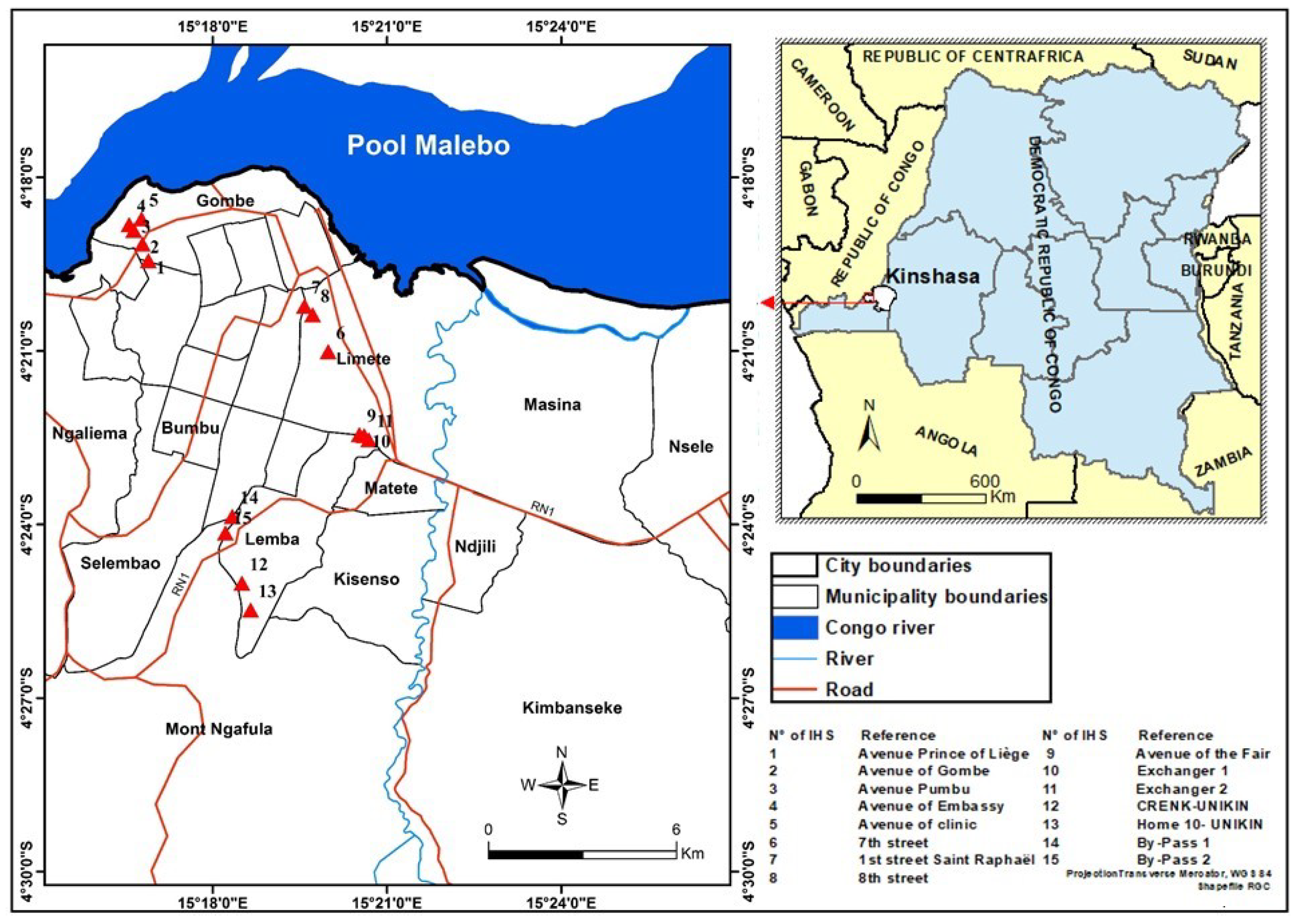
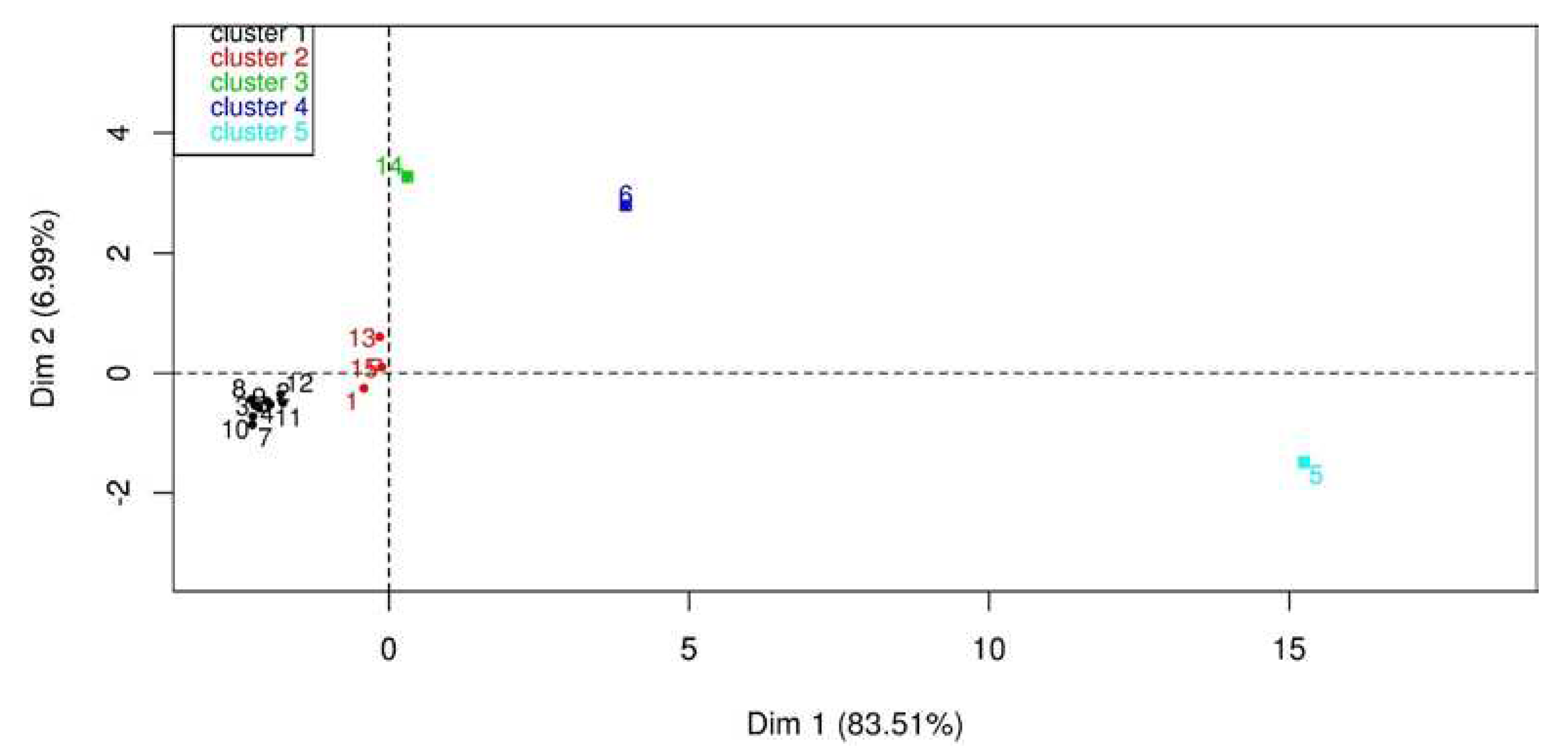
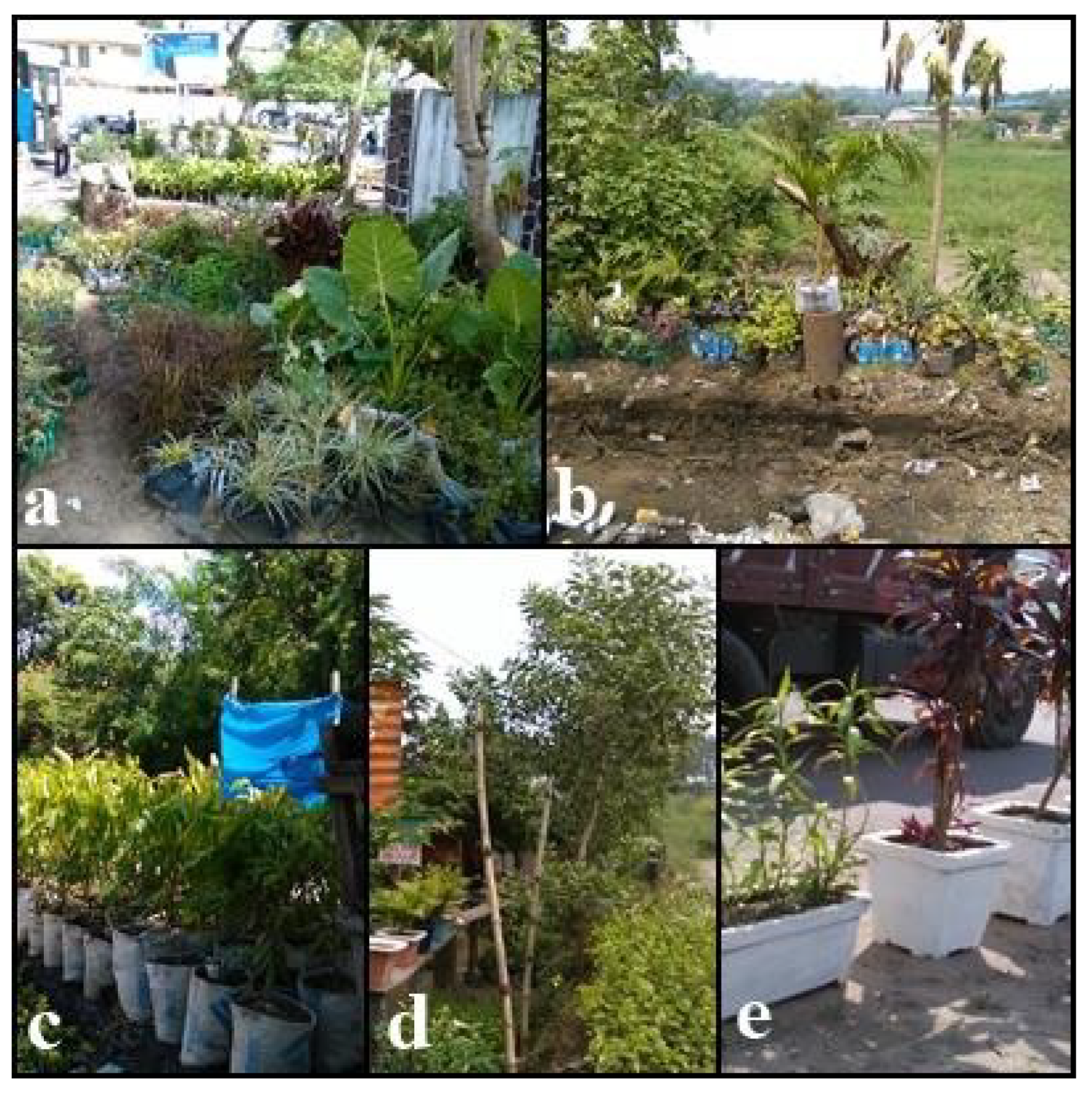
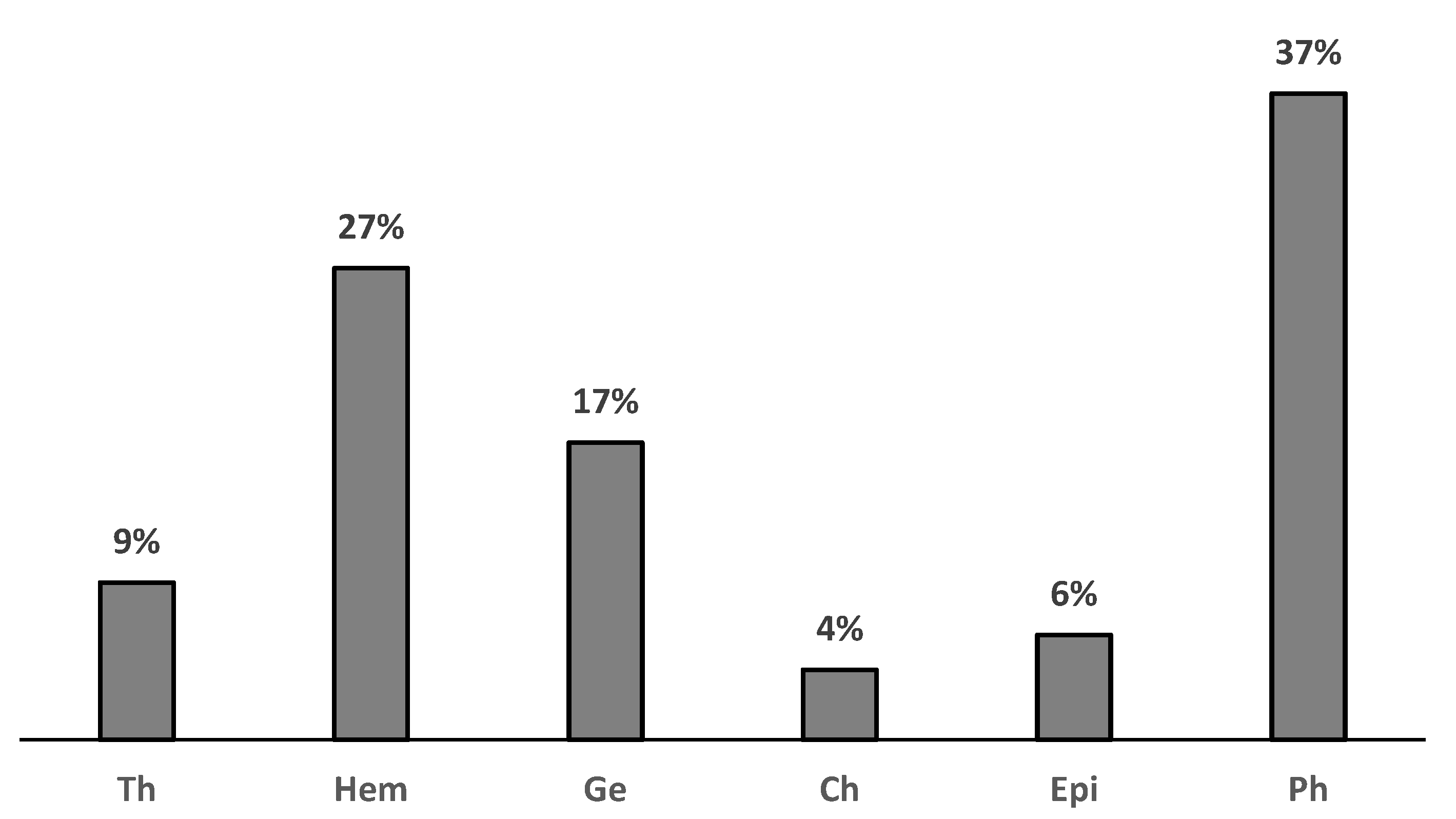
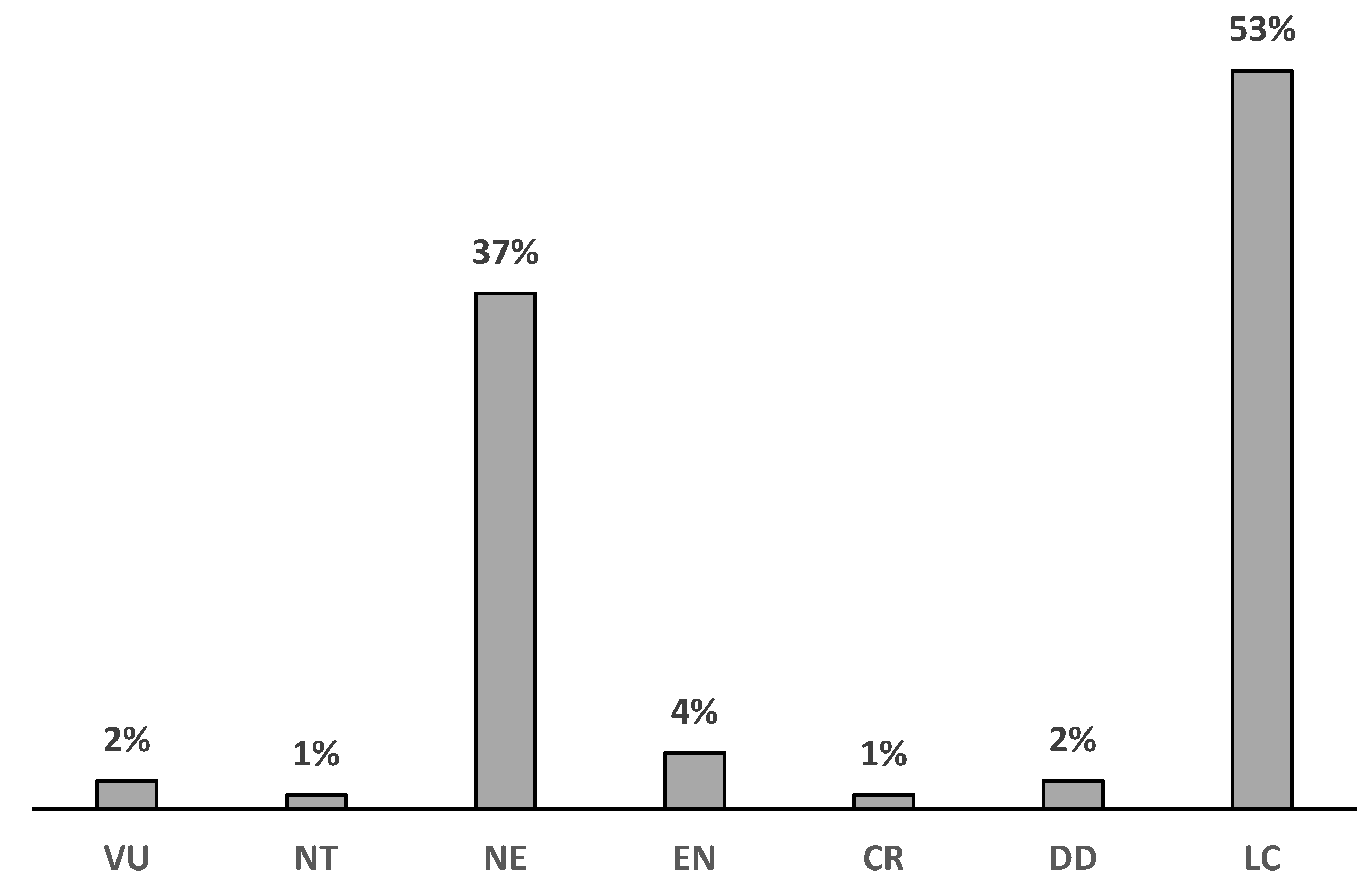
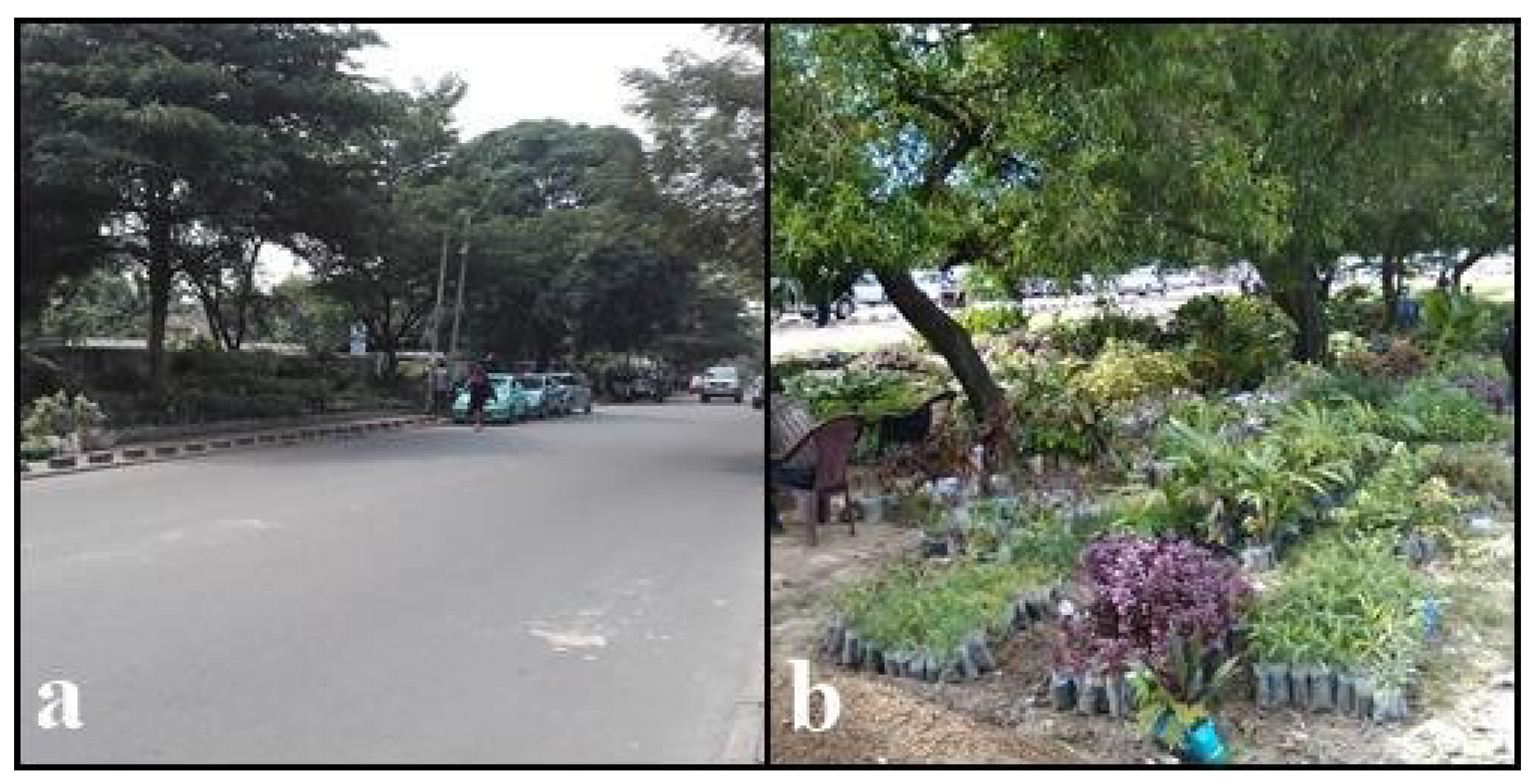
| Socio-Professional Characteristics | Gr Medium | Gr I | Gr II | Gr III | Gr IV | Gr V | |
|---|---|---|---|---|---|---|---|
| Number of sites | 15 | 9 | 3 | 1 | 1 | 1 | |
| Total workforce | 178 | 25 | 31 | 30 | 12 | 80 | |
| Type | Male | 178 | 25 | 31 | 30 | 12 | 80 |
| Female | 0 | 0 | 0 | 0 | 0 | 0 | |
| Average values of variables | m±es | m±es | m±es | m±es | m±es | m±es | |
| Work status | Employer | 8±12 | 2±1* | 8±3 | 20±0 | 6±0 | 50±0*** |
| Employee | 4±8 | 0±1* | 2±3 | 10±0 | 6±0 | 30±0*** | |
| Civil status | Married | 7±12 | 2±0 | 4±0 | 18±0 | 5±0 | 50±0*** |
| Single | 5±8 | 1±1* | 6±0 | 12±0 | 7±0 | 30±0*** | |
| <18 | 0±0 | 0±0 | 0±0 | 0±0*** | 2±0 | 0±0 | |
| 19-25 | 3±5 | 1±1* | 2±2 | 8±0 | 3±0 | 19±0*** | |
| Age group | 26-35 | 3±4 | 1±1* | 4±0 | 6±0 | 6±0 | 17±0*** |
| 36-45 | 4±8 | 1±1 | 4±1 | 8±0 | 0±0 | 33±0*** | |
| 46-55 | 1±3 | 0±1 | 1±0 | 4±0 | 0±0 | 11±0*** | |
| > 56 | 0±1 | 0±0 | 0±0 | 4±0 | 1±0*** | 0±0 | |
| No education | 3±4 | 0±0** | 3±2 | 8±0 | 7±0 | 16±0*** | |
| Education level | Primary | 3±5 | 1±1 | 2±1 | 10±0 | 1±0 | 20±0*** |
| Secondary | 3±5 | 1±1 | 4±0 | 4±0 | 2±0 | 22±0*** | |
| University | 3±6 | 0±1 | 1±2 | 8±0 | 2±0 | 22±0*** | |
| Nursery trade | Learned | 2±3 | 0±1** | 3±2 | 5±0 | 4±0 | 10±0*** |
| Improvised | 10±17 | 2±1* | 8±2 | 25±0 | 8±0 | 70±0*** | |
| Other activities | No | 9±16 | 2±1* | 6±2 | 30±0 | 6±0 | 61±0*** |
| Other activities | 3±5 | 1±1* | 4±2 | 0±0 | 6±0 | 19±0*** | |
| < 2 years | 2±3 | 1±1** | 4±2 | 5±0 | 3±0 | 10±0*** | |
| 3-5 years | 3±4 | 1±1** | 3±1 | 10±0 | 6±0 | 15±0*** | |
| Length of service | 6 -8 years | 4±7 | 1±1 | 2±3 | 10±0 | 2±0 | 30±0*** |
| 9- 12ans | 2±4 | 0±1 | 1±1 | 5±0 | 1±0 | 15±0*** | |
| > 12 years | 1±2 | 0±1 | 0±0 | 0±0 | 0±0 | 10±0*** | |
| Characteristics of production conditions | Proportions by horticultural site group (%) | P- value |
|||||
|---|---|---|---|---|---|---|---|
| Gr I | Gr II | Gr III | Gr IV | Gr V | |||
| n = 21 | n = 25 | n = 20 | n = 6 | n = 50 | |||
| Tacit contract | 43 | 84 | 30 | 33 | 0 | ||
| How to acquire production space | Formal contract | 57 | 16 | 70 | 67 | 100 | *** |
| Total | 100 | 100 | 100 | 100 | 100 | ||
| Annual fee | 48 | 16 | 70 | 67 | 100 | ||
| Existence of taxation | No tax | 52 | 84 | 30 | 33 | 0 | *** |
| Total | 100 | 100 | 100 | 100 | 100 | ||
| Seed acquisition mode | |||||||
| Yes | 100 | 100 | 100 | 100 | 100 | ||
| Second-hand purchase | No | 0 | 0 | 0 | 0 | 0 | ns |
| Total | 100 | 100 | 100 | 100 | 100 | ||
| Yes | 43 | 56 | 40 | 17 | 60 | ||
| Picking | No | 57 | 44 | 60 | 83 | 40 | ns |
| Total | 100 | 100 | 100 | 100 | 100 | ||
| Yes | 100 | 100 | 100 | 100 | 100 | ||
| Multiplication | No | 0 | 0 | 0 | 0 | 0 | ns |
| Total | 100 | 100 | 100 | 100 | 100 | ||
| Seedling packaging method | |||||||
| Yes | 100 | 100 | 100 | 100 | 100 | ||
| Plastic bag | No | 0 | 0 | 0 | 0 | 0 | ns |
| Total | 100 | 100 | 100 | 100 | 100 | ||
| Yes | 14 | 40 | 0 | 33 | 60 | ||
| Paper bag | No | 86 | 60 | 100 | 67 | 40 | *** |
| Total | 100 | 100 | 100 | 100 | 100 | ||
| Yes | 10 | 4 | 25 | 33 | 50 | ||
| Hard plastic pot | No | 90 | 96 | 75 | 67 | 50 | *** |
| Total | 100 | 100 | 100 | 100 | 100 | ||
| Yes | 24 | 0 | 0 | 0 | 0 | ||
| Concrete pot | No | 76 | 100 | 100 | 100 | 100 | *** |
| Total | 100 | 100 | 100 | 100 | 100 | ||
| Yes | 81 | 56 | 100 | 67 | 100 | ||
| Use of phytosanitary products | No | 19 | 44 | 0 | 33 | 0 | *** |
| Total | 100 | 100 | 100 | 100 | 100 | ||
| Yes | 0 | 0 | 0 | 0 | 0 | ||
| Supported by | No | 100 | 100 | 100 | 100 | 100 | ns |
| Total | 100 | 100 | 100 | 100 | 100 | ||
| Yes | 0 | 0 | 50 | 0 | 100 | ||
| Association organization | No | 100 | 100 | 50 | 100 | 0 | *** |
| Total | 100 | 100 | 100 | 100 | 100 | ||
| Scientific name | Family | OR | TB | SI | SC |
|---|---|---|---|---|---|
| Acalypha crenata Hochst. ex A. Rich. | Euphorbiaceae | Ex | Th | NI | LC |
| Acalypha hispida Burm. f. | Euphorbiaceae | Ex | Ph | NI | LC |
| Acalypha wilkesiana Müll.Arg. | Euphorbiaceae | Ex | Ph | NI | LC |
| Acanthus montanus T.Anderson | Acantanceae | Au | Ch | NI | LC |
| Aechmea bracteata (Sw.) Griseb. | Bromeliaceae | Ex | Epi | NI | LC |
| Agapanthus africanus (L.) Hoffmanns | Amaryllidaceae | Ex | Gé | PI | LC |
| Agave americana L. | Agavaceae | Ex | Ph | PI | LC |
| Aglaonema pictum (Roxb.) Kunth | Araceae | Ex | Gé | NI | LC |
| Albizia chinensis (Osbeck) Merr. | Fabaceae | Ex | Ph | PI | NE |
| Alcea rosea L. | Malvaceae | Ex | Hem | NI | LC |
| Allamanda cathartica L. | Apocynaceae | Ex | Ph | NI | LC |
| Alocasia macrorrhizos (L.) G. Don. | Araceae | Ex | Gé | PI | LC |
| Alocasia portei Schott | Araceae | Ex | Gé | PI | LC |
| Aloe congolensis De Wild. & T.Durand | Liliaceae | Au | Gé | PI | LC |
| Aloe vera (L.) Burm.f. | Liliaceae | In | Gé | PI | LC |
| Alpinia vittata W. Bull | Zingiberaceae | Ex | Gé | PI | LC |
| Alternanthera amoena (Lem.) Voss | Amaranthaceae | Ex | Hem | NI | NE |
| Alternanthera bettzickiana (Regel) G. Nicholson | Amaranthaceae | Ex | Hem | NI | NE |
| Alternanthera sessilis (L.) R.Br. ex DC. | Amaranthaceae | Ex | Hem | PI | LC |
| Alternanthera tenella Colla | Amaranthaceae | Ex | Hem | NI | NE |
| Ananas comosus (L.) Merr. | Bromeliaceae | Ex | Epi | NI | AT |
| Angelonia grandiflora C. Morr. | Scrophulariaceae | Ex | Hem | PI | NE |
| Anthurium andraeanum Linden ex André | Araceae | Ex | Gé | NI | NE |
| Anthurium sherzerianum Schott | Araceae | Ex | Gé | NI | NE |
| Antigonos leptopus H.& A. | Polygonaceae | Ex | Ph | PI | LC |
| Anubias hastifolia Engler | Araceae | Au | Gé | NI | LC |
| Araucaria excelsa (Lamb.) R. Br. | Araucariaceae | Ex | Ph | NI | LC |
| Araucaria heterophylla (Salisb.) Franco | Araucariaceae | Ex | Ph | NI | VU |
| Areca cathecu L. | Arecaceae | Ex | Ph | PI | DD |
| Arenga pinnata (Wurmb) Merr. | Arecaceae | Ex | Ph | NI | NE |
| Argemone mexicana L. | Papaveraceae | Ex | Th | PI | NT |
| Arisaema urashima H. Hara) H. Ohashi & J. Murata | Araceae | Ex | Gé | NI | NE |
| Aristolochia elegans Mast. | Aristolochiaceae | Ex | Gé | PI | LC |
| Artocarpus incisa (Parkinson) Fosberg | Moraceae | Ex | Ph | NI | NE |
| Arundo donax L. | Poaceae | Ex | Hem | PI | LC |
| Asparagus plumosus Baker | Liliaceae | Ex | Gé | PI | LC |
| Asplenium nidus L. | Aspleniaceae | Au | Hem | NI | LC |
| Aster amellus L. | Asteraceae | Ex | Hem | NI | LC |
| Ataenidia conferta (Benth.) Milne-Redh. | Marantaceae | Ex | Ph | NI | NE |
| Azadirachta indica A. Juss | Meliaceae | Ex | Ph | PI | LC |
| Bauhinia purpurea L. | Fabaceae | Ex | Hem | NI | LC |
| Bauhinia tomentosa L. | Fabaceae | Ex | Hem | NI | LC |
| Begonia eminii Warb. | Begoniaceae | Au | Epi | NI | AT |
| Begonia glabra Aubl. | Begoniaceae | Ex | Epi | NI | VU |
| Begonia rex Putz. | Begoniaceae | Ex | Epi | NI | LC |
| Begonia semperflorens hort. | Begoniaceae | Ex | Epi | NI | LC |
| Belamcanda chinensis L. | Iridaceae | Ex | Gé | NI | NE |
| Bellucia grossularioides (L.) Triana | Melastomataceae | Ex | Ph | NI | LC |
| Berlinia grandiflora (Vahl) Hutch. & Dalziel | Fabaceae | Au | Ph | NI | LC |
| Bidens sulphurea (Cav.) Sch.Bip. | Asteraceae | Ex | Th | NI | LC |
| Bignonia venusta Ker Gawl. | Bignoniaceae | Ex | Ph | NI | LC |
| Biophytum Zenkeri Guillaumin | Oxalidaceae | Au | Ph | NI | VU |
| Bixa orellana L. | Bixaceae | Ex | Ph | NI | LC |
| Borassus aethiopum Mart. | Arecaceae | Au | Ph | NI | LC |
| Bougainvillea glabra Choisy | Nyctaginaceae | Ex | Ph | NI | LC |
| Bougainvillea spectabilis Willd. | Nyctaginaceae | Ex | Ph | NI | NE |
| Breynia disticha J.R.Forst. & G.Forst. | Phyllanthaceae | Ex | Ph | PI | LC |
| Caesalpinia pulcherrima (L.) Sw. | Fabaceae | Ex | Ph | NI | LC |
| Caladium bicolore (Aiton) Vent. | Araceae | Ex | Gé | PI | CR |
| Calathea ornata (Linden) Körn. | Marantaceae | Ex | Hem | NI | NE |
| Calathea zebrina (Sims) Lindl. | Marantaceae | Ex | Hem | NI | NE |
| Callistephus chinensis (L.) Nees | Asteraceae | Ex | Th | NI | LC |
| Camellia japonica L. | Theaceae | Ex | Ph | NI | LC |
| Cananga odorata (Lam.) Hook. f. & Thomson | Annonaceae | Ex | Ph | NI | LC |
| Canna iridiflora Ruiz & Pav. | Cannaceae | Ex | Gé | NI | NE |
| Carludovica atrovirens H.Wendl. | Cyclanthaceae | Ex | Epi | NI | LC |
| Carludovica palmata Ruiz & Pav. | Cyclanthaceae | Ex | Epi | NI | LC |
| Catharanthus roseus (L.) G. Don | Apocynaceae | Ex | Hem | NI | NE |
| Celosia argentea L. | Amaranthaceae | Ex | Th | PI | LC |
| Celosia cristata L. | Amaranthaceae | Ex | Th | PI | LC |
| Chlorophytum comosum (Thunb.) Jacques | Asparagaceae | Ex | Hem | NI | LC |
| Cissus discolor Blume | Vitaceae | Ex | Ph | NI | NE |
| Codieum variegatum (L.) A.Juss. | Euphorbiaceae | Ex | Hem | NI | LC |
| Cosmos bipinnatus Cav. | Asteraceae | Ex | Th | NI | NE |
| Costus sanguineus Donnell Smith | Costaceae | Ex | Hem | NI | AT |
| Crinum americanum L. | Amaryllidaceae | Ex | Gé | NI | LC |
| Curculigo latifolia Dryand. ex W.T.Aiton | Hypoxidaceae | Ex | Gé | NI | LC |
| Cycas revoluta Thunb. | Cycadaceae | Ex | Ph | NI | LC |
| Cyclanthus bipartitus Poit. ex A.Rich. | Cyclanthaceae | Ex | Gé | NI | NE |
| Dahlia coccinea Cav. | Asteraceae | Ex | Hem | NI | NT |
| Dianthus caryophyllus L. | Caryophyllaceae | Ex | Hem | NI | LC |
| Dieffenbachia amoena hort. ex Gentil | Araceae | Ex | Ch | NI | DD |
| Duranta repens L. | Verbenaceae | Ex | Ph | NI | NE |
| Encephalartos cycadifoluis Jacquin | Cycadaceae | Ex | Ph | NI | LC |
| Episcia bicolor Hook. | Gesneriaceae | Ex | Hem | NI | NE |
| Eremochloa ophiuroides (Munro) Hack. | Poaceae | Ex | Hem | PI | NE |
| Euphorbia pulcherrima Willd. ex Klotzsch | Euphorbiaceae | Ex | Ph | NI | LC |
| Ficus repens auct. | Moraceae | Ex | Hem | NI | NE |
| Fittonia gigantea Linden | Acanthaceae | Ex | Hem | NI | NE |
| Galphimia gracilis Bartl. | Malpighiaceae | Ex | Ph | NI | NE |
| Gardenia jovis-tonantis (Welw.) Hiern | Rubiaceae | Au | Ph | NI | LC |
| Gomphrena globulosa L. | Amaranthaceae | Ex | Ch | NI | NE |
| Haemanthus multiflorus Martyn | Amaryllidaceae | Au | Gé | NI | LC |
| Helianthus annus L. | Asteraceae | Ex | Gé | NI | LC |
| Hibiscus rosa-sinensis L. | Malvaceae | In | Ph | NI | LC |
| Hippeastrum equestre (Aiton) Herb. | Amaryllidaceae | Ex | Gé | NI | NE |
| Hydranga macrophylla (Thunb.) Ser. | Hydrangeaceae | Ex | Ph | NI | NE |
| Impatiens balsamina L. | Balsaminaceae | Ex | Th | NI | LC |
| Ixora coccinea L. | Rubiaceae | Ex | Hem | NI | LC |
| Jasmin officinale L. | Oleaceae | Ex | Ph | NI | NE |
| Jatropha curcas L. | Euphorbiaceae | Ex | Ph | NI | LC |
| Kalanchoe delagoensis Eckl. & Zeyh. | Crassulaceae | Ex | Hem | PI | NE |
| Kalanchoe pinnata (Lam.) Pers. | Crassulaceae | Ex | Hem | PI | NE |
| Kalanchoe tomentosa Baker | Crassulaceae | Ex | Hem | PI | NE |
| Lantana camara L. | Verbenaceae | Ex | Ph | PI | NE |
| Lonicera longiflora (Lindl.) DC. | Caprifoliaceae | Ex | Ph | NI | NE |
| Malpighia coccigera L. | Malpighiaceae | Ex | Ph | NI | NE |
| Maranta bicolor Ker Gawl. | Marantaceae | Ex | Hem | NI | NE |
| Mimoza asperata L. | Fabaceae | Ex | Ph | PI | LC |
| Mirabilis Jalapa L. | Nyctaginaceae | Ex | Hem | NI | LC |
| Monstera deliciosa Liebm. | Araceae | Ex | Ch | NI | NE |
| Nephrolepis acuminata (Willd.) C. Presl | Polypodiaceae | Ex | Ch | NI | NE |
| Nerium oleander L. | Apocynaceae | Ex | Ph | NI | LC |
| Pandanus furcatus Roxb. | Pandanaceae | Ex | Ph | NI | AT |
| Pelargonium carpitatum (L.) L’Hér. | Geraniaceae | Ex | Hem | NI | NE |
| Phlox drummondii Hook. | Portulacaceae | Ex | Th | NI | AT |
| Phyllanthus nivosus W. Bull | Phyllanthaceae | Ex | Ph | NI | LC |
| Pilea muscosa Lindl. | Uriacaceae | Ex | Hem | NI | LC |
| Plumbago auriculata Lamarck | Plumbaginaceae | Ex | Ph | NI | NE |
| Polianthes tuberosa L. | Asparagaceae | Ex | Gé | NI | NE |
| Portulaca grandiflora Hook. | Portulacaceae | Ex | Ch | NI | LC |
| Ravenala madagascarensis Sonn. | Strelitziaceae | Ex | Ph | NI | LC |
| Rhoeo discolor (L’Hér.) Hance ex Walp. | Commelinaceae | Ex | Hem | NI | DD |
| Rosa simensis Hibiscus rosa-sinensis L. | Malvaceae | Ex | Ph | NI | NE |
| Roystonia regia (Kunth) O.F.Cook | Araceae | Ex | Ph | NI | LC |
| Salvia splendens Sellow ex Schult. | Labieae | Ex | Hem | NI | NE |
| Sanchezia nobilis Hook. f. | Acanthaceae | Ex | Ph | NI | NE |
| Sansaviera trifasciata Prain | Asparagaceae | Au | Gé | PI | NE |
| Selaginella apus (L.) Spring | Selaginellaceae | Ex | Hem | NI | LC |
| Senna alata (L.) Roxb. | Fabaceae | Ex | Ph | PI | LC |
| Senna occidentalis (L.) Link | Fabaceae | Ex | Ph | PI | LC |
| Senna spectabilis (DC.) H .S. Irwin & Barneby | Fabaceae | Ex | Ph | PI | LC |
| Setcreasea purpurea Boom | Commelinaceae | Ex | Hem | NI | NE |
| Spathiphyllum blandum Schott | Araceae | Ex | Hem | NI | NE |
| Syngonium auritum (L.) Schott | Araceae | Ex | Ph | PI | NE |
| Tagette erecta L. | Asteraceae | Ex | Th | NI | NE |
| Tithonia tagetiflora Desf. | Asteraceae | Ex | Hem | NI | LC |
| Torenia fournieri Linden ex E. Fourn. | Scrophulariaceae | Ex | Th | PI | NE |
| Zinnia angustifolia Kunth | Asteraceae | Ex | Th | NI | NE |
Disclaimer/Publisher’s Note: The statements, opinions and data contained in all publications are solely those of the individual author(s) and contributor(s) and not of MDPI and/or the editor(s). MDPI and/or the editor(s) disclaim responsibility for any injury to people or property resulting from any ideas, methods, instructions or products referred to in the content. |
© 2023 by the authors. Licensee MDPI, Basel, Switzerland. This article is an open access article distributed under the terms and conditions of the Creative Commons Attribution (CC BY) license (http://creativecommons.org/licenses/by/4.0/).





